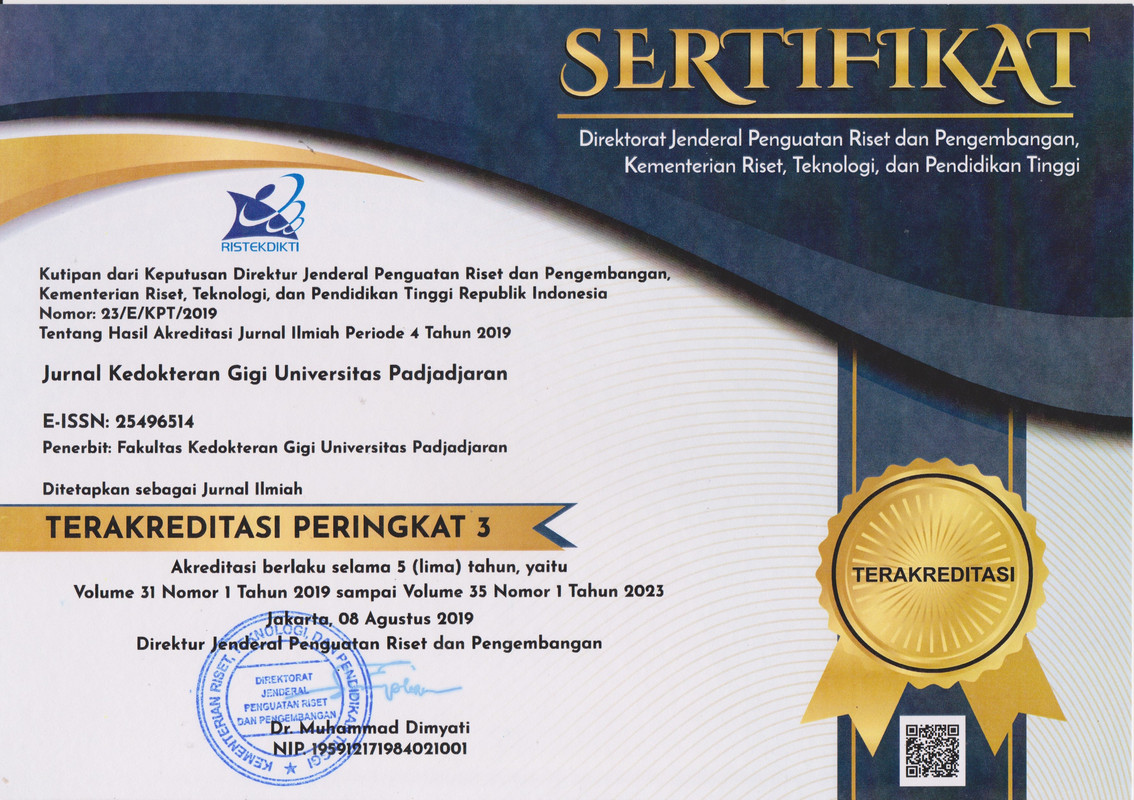Performa porselen fusi logam dan porselen penuh
Performance of metal fusion and pure porcelain
Abstract
Pendahuluan: Permintaan porselen sebagai salah satu bahan restorasi kedokteran gigi semakin meningkat. Secara umum, praktisi mengetahui bahwa terdapat dua jenis porselen yang dapat dipesan dari laboratorium kedokteran gigi yaitu porselen fusi logam dan porselen penuh. Namun, praktisi sering bingung dalam memilih restorasi yang tepat sesuai kasus. Studi pustaka ini bertujuan untuk memberikan pengetahuan untuk membantu praktisi dalam memilih penggunaan porselen fusi logam atau porselen penuh. Studi Pustaka: Porselen fusi logam memiliki kekuatan dan kekerasan yang lebih tinggi daripada beberapa jenis porselen penuh. Namun, porselen fusi logam memerlukan ruang yang lebih tebal dan kandungan logamnya mengurangi estetik. Porselen fusi logam juga bertentangan dengan konsep metal-free dentistry. Harga logam yang lebih murah menyebabkan harga restorasi porselen fusi logam juga lebih murah dibanding porselen penuh. Penentuan performa yang lebih baik, dapat dilakukan melalui evaluasi dengan melihat bahan yang digunakan pada suatu restorasi. Evaluasi holistik dan struktural juga perlu dilakukan untuk mengetahui performa pada kesatuan restorasi. Kelebihan dan kekurangan porselen fusi logam dan porselen penuh perlu dijadikan pertimbangan dalam pemilihan dan penempatan restorasi yang akan digunakan. Simpulan: Performa yang lebih baik akan ditunjukkan apabila jenis porselen disesuaikan dengan karakteristik gigi asli dan keadaan mukosa oral yang digantikan serta sesuai dengan keinginan dan kemampuan pasien.
Kata kunci: Porselen fusi logam, porselen penuh.
ABSTRACT
Introduction: The demand for porcelain as one of the restorative materials for dentistry is increasing. Generally, practitioners know that there are two types of porcelain can be ordered from dental laboratories, namely metal fusion porcelain and pure porcelain. However, practitioners often confused in choosing the right restoration for a case. This literature study was aimed to provide the knowledge to help practitioners choose the proper porcelain. Literature Review: Metal fusion porcelain had higher strength and hardness than some full porcelain types. However, metal fusion porcelain required thicker space and reduced metal content. Metal fusion porcelain also contradicted with the concept of metal-free dentistry. Lower metal prices caused the price of metal fusion porcelain restorations to be having the lower cost than pure porcelain. Determination of better performance can be done through evaluation by looking at the materials used in restoration. The holistic and structural evaluation also needs to be done to determine the performance of the restoration unit. The advantages and disadvantages of metal fusion porcelain and full porcelain need to be taken into consideration in the selection and placement of the restoration to be used. Conclusion: Better performance will be shown if the type of porcelain adapted to the characteristics of the original tooth and the oral mucosal conditions replaced as well as by the patient’s wishes.
Keywords: Metal fusion porcelain, pure porcelain.
Keywords
Full Text:
PDFReferences
Geissberger M. Esthetic dentistry in clinical practice. 1st ed. San Fransisco: Blackwell Publishing; 2010. h. 70-80.
Anusavice K. Phillips’ science of dental material. 12th ed. Amsterdam: Elsevier; 2013. p. 680–740.
Babu PJ, Alla RK, Alluri VR, Datla SR, Konakanchi A. Dental ceramics: Part I – An overview of composition, structure, and properties. Am J Mater Engineer Techn 2015;3(1):13–8.
Sakaguchi RL, Powers JM. Craig’s restorative dental materials. 13th ed. Amsterdam: Elsevier; 2012. h. 253-76.
Denry I, Holloway JA. Ceramics for dental applications: A review. J Mater 2010;3(1):351–68.
Hatrick CD, Eakle S, Bird WF. Dental materials clinical application for dental assistans and dental hygienists. 2nd ed. Missouri: Saunders Elsevier; 2011. h. 318-33.
Helvey GA. Classification of dental ceramics. Inside Continuing Education 2013;13:62-8.
McCabe J, Walls A. Applied dental materials. 9th ed. Oxford: Blackwell Pub; 2008. h. 89-100.
McEntire BJ, Lakshminarayanan R, Thirugnasambandam P. Processing and chracterization of silicon nitride bioceramics. Bioceram Dev Appl. 2016;6(93):1-10.
McMillan PW. Glass-ceramics. 2nd ed. London: Academic Press Inc.; 1964. h. 214-20.
Panzera C, Mead B, Kalser LM. Dental porcelain composition. United states patent application 1999;54(17):1-6.
Raghavan RN. Ceramics in dentistry, sintering of ceramics-new emerging techniques. India: 2012. Tersedia pada:https://www.intechopen.com/books/sintering-of-ceramics-new-emerging-techniques/ceramics-in-dentistry. DOI: 10.5772/39090.
Katz S. Translucent dental porcelain composition, its preparation and a restoration made thereof. European Patent Application 1987;53(9):1-15.
Santos DF, Andrade MC, Sampaio JA. Production and characterization of colored feldspathic enamel for dental aplication. Materials Research 2013;17(IV):289–94.
Shenoy A, Shenoy N. Dental ceramics: An update. Journal of Conservative Dentistry 2010;13(4):195–203. Available from: http://doi.org/10.4103/0972-0707.73379.
Digital Object Identifier
DOI : https://doi.org/10.24198/jkg.v29i3.15952Dimension Citation Metrics Badge
Refbacks
- There are currently no refbacks.
Copyright (c) 2017 Jurnal Kedokteran Gigi Universitas Padjadjaran
INDEXING & PARTNERSHIP
Refbacks
- There are currently no refbacks.
Copyright (c) 2017 Jurnal Kedokteran Gigi Universitas Padjadjaran
INDEXING & PARTNERSHIP

Jurnal Kedokteran Gigi Universitas Padjadjaran dilisensikan di bawah Creative Commons Attribution 4.0 International License






.png)















